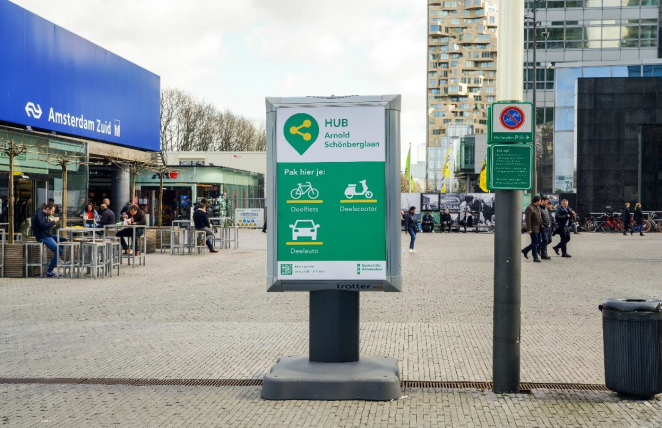As the Neighbourhood Hubs implementation programme prepares for its launch, the city has developed a communication plan to ensure that communication supports the objectives.
The city of Amsterdam has set its target to become liveable and accessible, and Hubs are a big part of this strategy. For that reason, the City council adopted the Amsterdam Hub Vision in December 2021. Shared mobility hubs are more than infrastructure, they bring a new vision to mobility and public space. For it to succeed, the City is convinced of applying its vision to every level of the city involving everyone in the process. Neighbourhood hubs, a new concept introduced by the city, are an important building block for the realisation of a clean and car-lite city. One initiative is setting up Neighbourhood Hubs in collaboration with the Transport Authority for the Amsterdam Region. By seeking collaboration with various knowledge institutions and clear agreements with the region and market players, it is possible to achieve a unified system that is recognisable and functional for users.
As the Neighbourhood Hubs implementation programme prepares for its launch, the city has developed a communication plan to ensure that communication supports the objectives of the Neighbourhood Hubs. This strategy ensures that stakeholders, users, and communities understand, embrace, and actively engage with the hubs. Here’s how Amsterdam achieves this, with insights that other cities can adapt to their contexts.
Context-sensitive communication: tailored messaging for each hub
Amsterdam's hubs vary in scale and purpose, from small neighbourhood hubs to larger district and regional hubs. Communication is tailored accordingly, from neighbourhood hubs that require localised campaigns with door-to-door outreach, resident consultations, and posters in community spaces, district hubs with mixed-use zone and engagement with both businesses and residents to regional hubs where the messaging focuses on their role as major transit nodes, highlighting connections to regional transport systems and their environmental benefits.
For that the city provides a stakeholder and audience analysis for each hub type, as Amsterdam does, to adapt messages effectively.

Unified Branding across projects
To ensure hubs are easily recognisable, Amsterdam employs consistent branding and iconography. A distinctive design language ensures uniformity while allowing for local adaptation. Hubs are visually coherent and prominently marked, making them user-friendly for both residents and visitors. The branding extends to digital platforms, ensuring consistency across online and offline touchpoints.
Early and broad engagement with stakeholders
Amsterdam’s approach is highly collaborative, involving stakeholders through different frameworks to align goals and ensure accountability from the start.
The city works closely with shared mobility providers, ensuring they are part of the planning process. Providers are responsible for promoting their own services, but Amsterdam’s overarching campaigns support this alignment. Residents are actively involved in determining the modes of transport at each neighbourhood hub, fostering a sense of ownership. Lastly, the city of Amsterdam is promoting cross-department coordination internally. By aligning different departments not only within the traditional mobility sectors but including others like Economic Affairs, Real Estate, Services, ... to ensure consistency in communication and implementation.
Digital and on-the-ground presence
Amsterdam combines digital tools and in-person outreach to maximise visibility and will develop a toolkit refining their strategies:
- Digital Tools.The website www.amsterdam.nl/hubs serves as the central hub for information, offering maps, FAQs, and updates. Social media channels amplify awareness through targeted posts.
- In-Person Campaigns. Posters, flyers, and trial promotions are used to generate local interest. Events like hub openings and demo days encourage residents to try the services.
Participation as a core strategy
Participation goes beyond consultation; Amsterdam integrates communities into decision-making, where residents are involved in selecting the shared mobility options available at hubs. This also relates to the implementation and the upscaling of their shared mobility services as trial promotions and pilot projects allow users to experience hubs before full-scale rollout, as well as feedback mechanisms, such as surveys and direct communication via a central email address, ensure continuous improvement.
Data-driven adjustments: refining strategies dynamically
Amsterdam monitors the impact of its communication strategies to make evidence-based adjustments:
- Metrics like website visits, social media engagement, and hub usage provide insights into public interest.
- Stakeholder attitudes are tracked to assess perceptions and identify areas for improvement.
- The city evaluates user feedback from events and surveys to refine future campaigns.
Key takeaways for communication plans
Amsterdam’s shared mobility hubs highlight the power of a strategic, layered communication approach. Key lessons include:
- Start internally. Build internal buy-in to align your organisation and amplify external messaging.
- Anchor the vision. Position hubs as essential nodes in a multimodal transport network, linking them to broader city goals like sustainability and accessibility.
- Shape perception. Proactively manage narratives through media and digital channels to influence public opinion and counter resistance.
- Engage communities and generate positive experiences. Involve residents and stakeholders early in the process to foster ownership, trust, and practical insights.
- Empower early adopters: Leverage the enthusiasm of early users to advocate for the project and generate momentum.
